A Winter Tour today, down in the Norfolk Broads. It was a glorious, sunny winter’s day, with blue skies and mostly light winds. Perfect weather to be out birding!
Our first destination was Ludham. This is a regular wintering area for Bewick’s and Whooper Swans, and we hoped to catch up with some here this morning. Numbers are lower than normal this winter, with mild weather on the continent meaning the majority of the swans have opted to remain further east this year. Still, there are a few around to see.
As we parked and got out of the car, a Chinese Water Deer was feeding out on the grazing marsh opposite, the first of many of this increasingly widespread non-native deer we would see today. A flock of Fieldfare flew up ‘tchacking’ and landed behind some barns and a Redwing called from the trees before flying down and landing on a fence where we could get a good look at it in the scope. We would see lots of these winter thrushes on our travels today too.
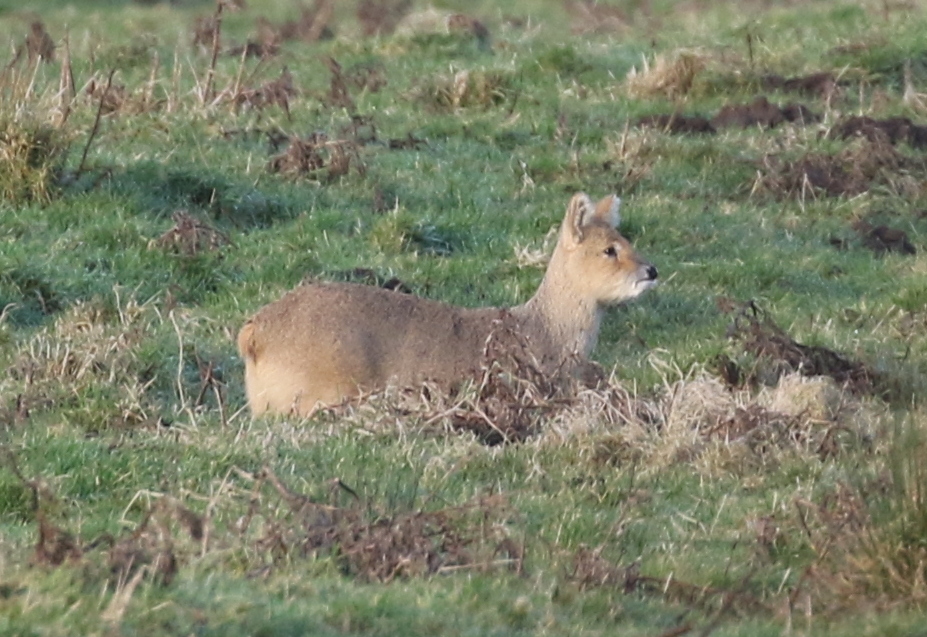
As we walked up onto the river bank, a Bearded Tit called from the reeds below us and we had a quick glimpse of it as it flew a short distance over the tops of the reeds before darting back in. It did the same thing a couple more times, but you had to be really quick to see it. Several Reed Buntings flew up from the reeds too.
Suddenly we picked up the sound of swans approaching, their honking calls getting steadily louder until we picked up a flock of about thirty birds flying in over the trees. It is a wonderful sound, to hear wild swans calling as they fly in, particularly on a bright sunny winter’s morning like today. They appeared to be all Bewick’s Swans – we could see the more restricted, squared-off yellow patches on their bills as they caught the light.
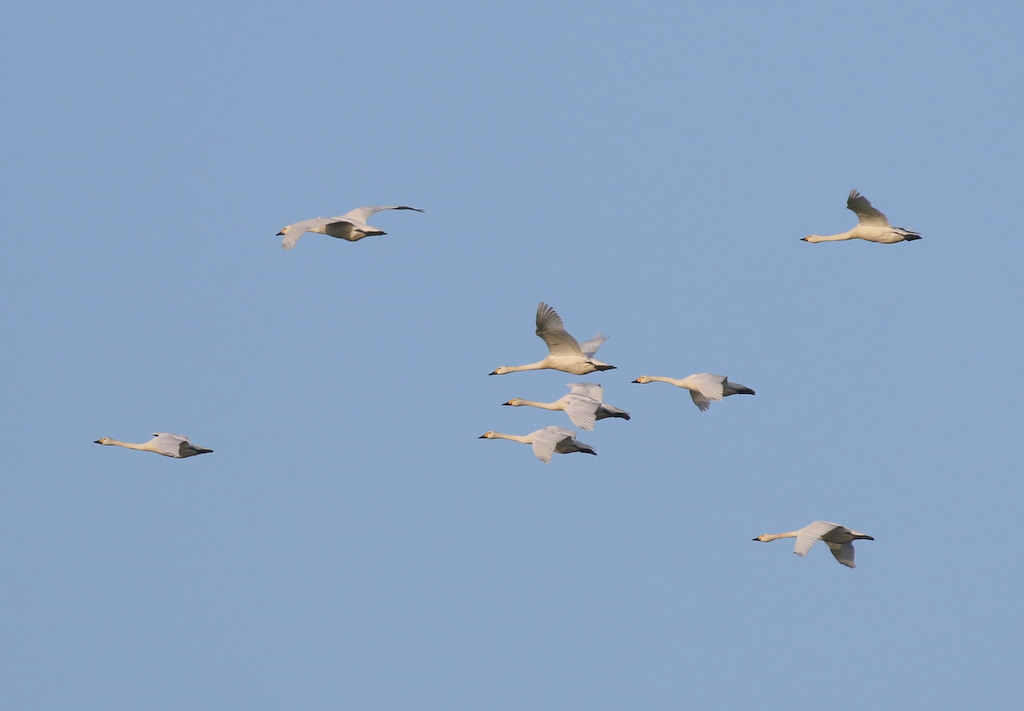
The Bewick’s Swans circled over the Levels calling, before dropping down to the grass. There were a few Mute Swans scattered over the grazing meadows, but they dropped down to join a small group of feral white geese on the edge of a small pool. The Bewick’s Swans started feeding on the grass or bathing in the pool beyond.
Scanning carefully through the Bewick’s Swans, we noticed a larger bird with them, longer-necked, and with a long wedge-shaped yellow patch on its bill, which tapered to a finer point. It was a single Whooper Swan. It didn’t appear to have come in with the Bewick’s Swans, so perhaps it was in the pool when they arrived. It was good to see the two species side by side in the scope.

We stood on the bank for a few minutes scanning the marshes. There were lots of Lapwings scattered about the damp grass, along with a smaller flock of Golden Plover which flushed from the field beyond and whirled round in a tight group. A smart male Marsh Harrier was hunting along the line of reeds at the back of the grass.
With both the swans in the bag, we decided to head down to the coast next. The short drive over was fairly uneventful, but when we got down to the coast road we started to see more birds. A large herd of Mute Swans was feeding in the water-logged fields and there were loads of Lapwings and Golden Plover hiding in the young oilseed rape nearby.
We stopped in a convenient layby and got out to scan the fields. A few hundred Pink-footed Geese flew in and landed out on a grassy field opposite, with smaller groups flying in every few minutes to join them. A Red Kite circled lazily overhead and a Sparrowhawk zipped low and fast across the stubble field behind us. This is often a very good area for Common Cranes, but there were none visible feeding out in the fields here this morning.
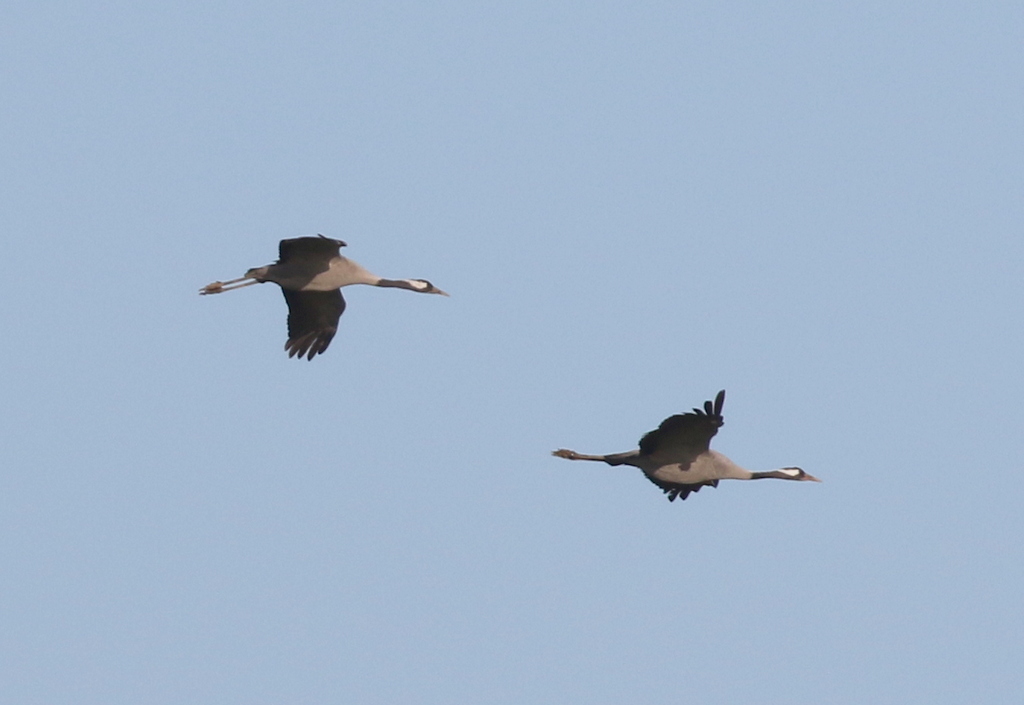
Then, turning to look behind us, we noticed two huge birds flying over the trees, long necks stretched out in front and long legs trailing behind, a pair of Cranes. At first it looked like they would drop back down behind the trees, but then they turned and flew straight towards us, turning in front of us and gliding across the road. A great view and wonderful to listen to these majestic birds, their loud bugling calls are a real sound of the Broads at this time of year.
The Cranes headed out towards the coast and dropped down out of view in the distance, but a few seconds later they reappeared flying back towards us. They appeared to land on the other side of the road, a short way further north behind some reeds, so we started to pack up, intending to drive along to try to see them there. But as we turned we noticed another pair of Cranes had circled up right behind us. They started bugling too and we watched as they dropped away behind some trees.
It was all action – we didn’t know where to look! The Cranes in the Broads are getting territorial again now, reclaiming their grounds, and we appeared to be in the middle of a territorial dispute between two rival pairs. The first pair of Cranes took off again and flew back across the road, heading for the area where the second pair had just landed, with both pairs bugling. But as they approached the trees they gained height and turned away, back in the direction they had originally come from.

It is one of the great sights and sounds of the Norfolk Broads at this time of the year – watching and listening to the Cranes. These birds are part of a population which re-established itself naturally, with the first birds arriving probably as wanderers from the continent right here in 1979. They first bred successfully in 1982, after an absence from the UK of around 400 years, and have grown steadily in number since the 1990s, spreading to other parts of the country. They are not part of the ‘Great Crane Project’ which released large quantities of captive-raised Cranes onto the Somerset Levels.
After being treated to a magnificent display from the Cranes, we popped in at Waxham next. There had been a Hume’s Warbler here for several weeks and, with such good weather, we thought it worth a quick look to see if it is still hiding somewhere. We didn’t spend very long here, but there was no immediate sign of it and the trees were otherwise pretty quiet, as was the sea, so we moved swiftly on.
Our next destination was the Yare Valley. We stopped at Cantley and walked down to scan the grazing marshes. There were good numbers of Pink-footed Geese out on the grass and with careful scanning we found a small number of White-fronted Geese too, though they were mostly keeping down in the low-lying wetter patches. There was no sign of any Taiga Bean Geese here today – these birds seem to have deserted the Yare Valley already this year, having not been seen here since the very start of January.
There were lots of waders out on the grass too, mainly Lapwing. Scanning carefully through them, we found a small number of Ruff too, though they were rather distant and hard to see from here. The waders were rather jumpy anyway, but when they all took off in unison we scanned the sky and quickly found the cause – a Peregrine. It was some way off, over towards the river, and it quickly lost interest and powered off towards Buckenham.
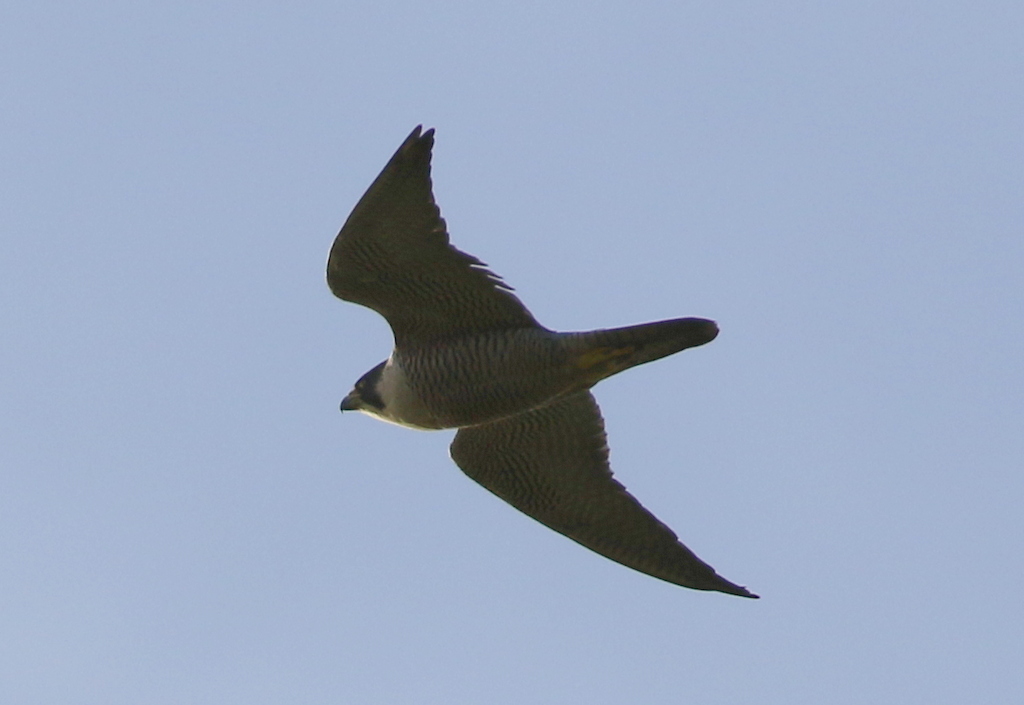
As well as being distant, that Peregrine was hard to see in the melee of birds which it had successfully induced. Thankfully, just a minute or so later, either that Peregrine or possibly a different appeared right over our heads, flying off towards the nearby beet factory. A much better view! We also had a good look at a female Marsh Harrier from here, standing down in the grass.
It was time for lunch, so we headed round to Strumpshaw Fen to make use of the facilities. A Mistle Thrush was singing from the top of the trees by Reception Hide, another sign that spring is on its way! With only peanuts and niger seed feeders out here at the moment, the Marsh Tits seem to have lost interest and didn’t come in today, just a steady succession of Blue and Great Tits while we ate.
There were not so many ducks on the pool here today – a few Gadwall and Mallard. The Coot were starting to squabble and fight and the resident feral Black Swan was preening itself right in front of the screen. A Marsh Harrier or two quartered the reedbed beyond periodically.
After lunch, we headed round to nearby Buckenham Marshes. It was a lovely sunny afternoon to walk out here, down towards the river, but at first sight it appeared rather quiet. The only geese on view were the local Canada Geese and feral flock of Barnacle Geese. The latter are very smart bird and got a deserved look through the scope. A handful of Greylags were asleep over the other side.
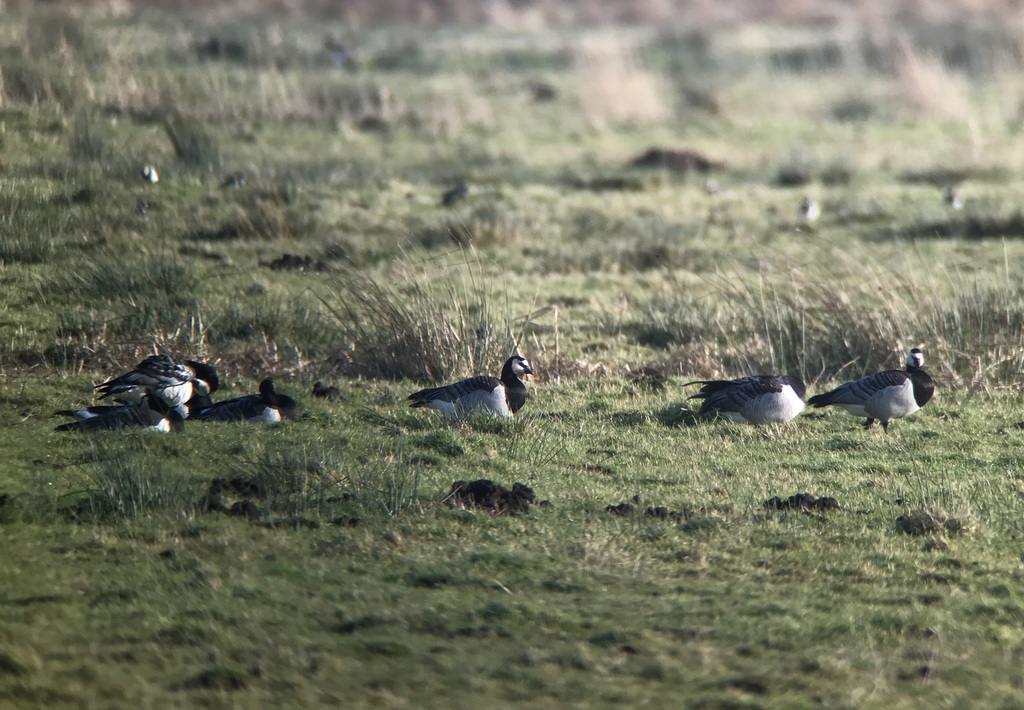
On closer inspection, there were lots of Lapwing out on the grass and when they flew round at one point we noticed a good number of Ruff with them too. They landed closer to us and we managed to get a better look at them than the ones we had seen at Cantley earlier. Two much smaller Dunlin flew in land landed on a pool in the grass too.
As we got out towards the river, we found the ducks. Several Shoveler were swimming around in one of the drainage ditches, along with a couple of Wigeon and a few sleeping Teal on the bank. Further along, we could see several hundred Wigeon asleep on the main pool, with a scattering of the other two species mixed in.
Numbers of Wigeon in Norfolk appear to be down this winter too, with many of these remaining on the continent like the swans this year. We did however get a really good look at some which were feeding right next to the path as we walked out – smart ducks!

There was nothing much happening down at the river, so we decided to head quickly back to the car and move on.
The last few winters, there has been an adult Rough-legged Buzzard which returns each year to Haddiscoe Island. There was no sign of it at the end of last year, but in the last few days it has reappeared. We headed down to a suitable vantage point overlooking the area it favours and scanned the posts and gates where it likes to stand.
It didn’t take long to find it. The Rough-legged Buzzard was perched on a post out in the middle. It was rather distant and face on to us at first, but we could see its rather blackish throat and upper breast, contrasting with a whitish top to the head, and black patches on either side of its belly, set off by a bold whitish band across the lower breast and down through the middle.

The Rough-legged Buzzard then helpfully turned round and we could see the pale top to the head and liberal white speckling to the dark upperparts. At one point, it preened and we got a quick flash of the white base to its tail. Unfortunately, we were looking elsewhere when it moved to another post!
There were several Common Buzzards here too, giving us an opportunity to compare the two species. A nice pale one had extensive off-white head and underparts, lacking the contrasting dark patches underneath of the Rough-legged Buzzard. A more typical darker Common Buzzard had noticeably rich brown on breast and belly in the sunlight, not the blackish colour of the Rough-legged Buzzard.
A female Marsh Harrier passed by just in front of us and there were several Kestrels out on the posts in the middle of the island too. But we were probably still a bit too early today for any owls and we had a long journey to get back for our last stop of the day.
As we walked out along the track towards Stubb Mill, several more Redwings and Fieldfares flew out of the hedges calling, a real theme of the day. A small flock of Linnets perched in the top of a tree in the afternoon sunlight. We heard the dulcet tones of a quad bike heading out over the marshes and saw a pair of Cranes fly up. The landowner was heading out to put some feed down on his duck flight pond. The Cranes circled round and appeared to go down in front of the raptor watchpoint the other side of the old mill, so we hurried round to try to see them.
The watchpoint was unbelievably busy this evening, the busiest we have ever seen it – probably everyone was out because of the good weather. They had all spread themselves out along the bank (even leaving space for a stool to sit on), and not left anywhere for the late arrivals like us to stand, so we made ourselves rather unpopular by asking people to shuffle along and make some room. There was plenty of space for everyone, but the process involved a surprising amount of grumbling from sections of the crowd! Our apologies if we upset anyone unduly!!
When we eventually got a space to stand and set up the scope, we discovered there were two pairs of Cranes on view out on the grass this evening. We had a nice view of them on the ground, to compliment the ones we had seen flying round earlier. Striking birds, with their long black and white necks and bustle of feathers over the tail.
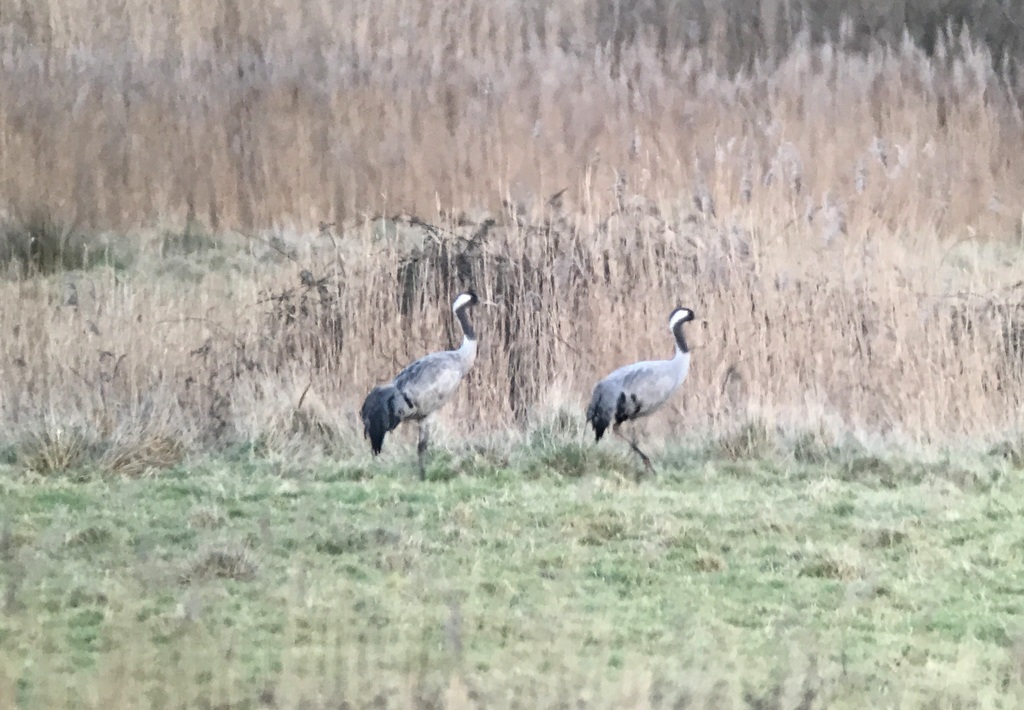
When the quad bike returned, the landowner got off and came over for a chat with us about the birds and what else we had seen. We watched as several Shelduck flew in and dropped down behind the reeds to the duck pond to feed on the newly delivered grain. They were followed shortly after by one of the pairs of Cranes, the one which had left there earlier and which flew back to take advantage of the food provided.
There were raptors too. A steady stream of Marsh Harriers flew in from all directions and out to the reedbed to roost. We could see several perched in the bushes in the distance, getting ready to go in. A ringtail Hen Harrier flew in along the back of the grazing marshes and, a little later, we spotted a ghostly grey male Hen Harrier in the distance, weaving in and out of the bushes out where they roost.
There was more Crane action as birds started to fly in to roost. First a pair flew across slowly in front of us, then another pair came in over the trees just behind the watchpoint. It is always a great way to end the day, watching the Cranes flying in, listening to them bugling and others answering from the marshes.
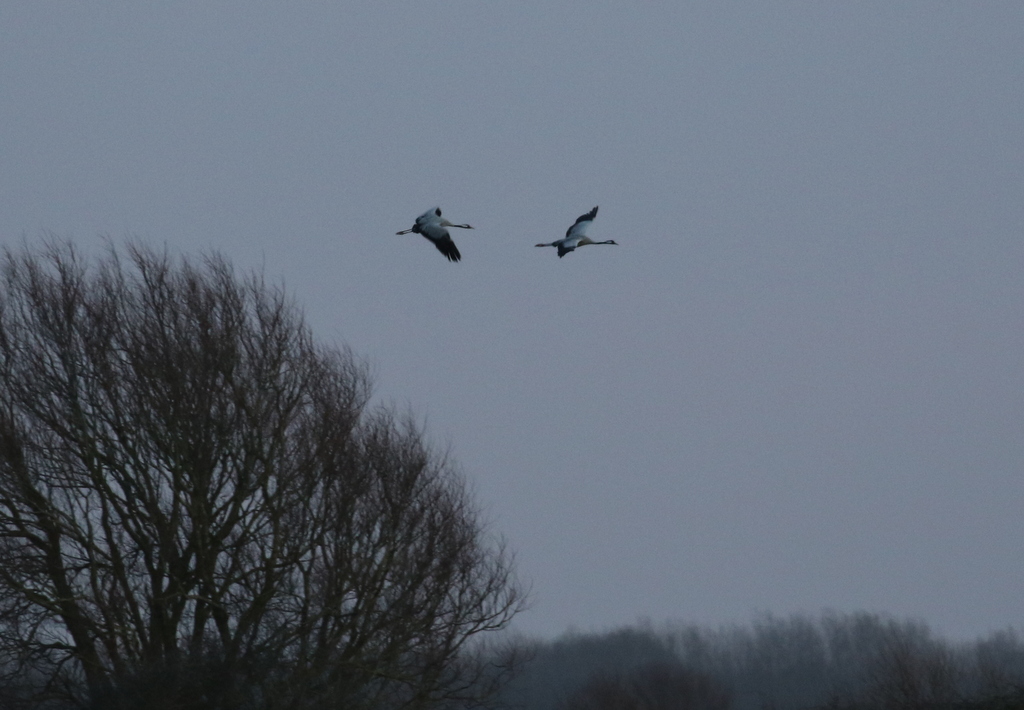
A Tawny Owl hooted from the trees by the old mill, which was the cue for us to start thinking about heading back. As we walked back, another group of eight Cranes came in over the trees, over the road, and dropped down towards the marshes beyond. It was quite a sight, against the last of the pink and orange sunset. As we got back to the car park, a Woodcock shot over, heading out to feed on the marshes. It was time for us to head for home.
















